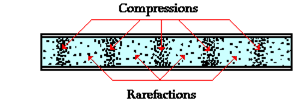Difference between revisions of "How Sound Works"
| Line 13: | Line 13: | ||
<gallery> | <gallery> | ||
| − | This image shows our molecules being compressed and rarefied in air. Time is the horizontal axis, and pressure is the vertical axis.<br /> | + | This image shows our molecules being compressed and rarefied in air. Time is the horizontal axis, and pressure is the vertical axis. |
| + | |||
| + | |||
| + | <br /> | ||
Revision as of 13:45, 22 October 2013
Sound moves thru air by compressing and rarefying (lowering the ambient pressure) of air molecules. The waves move thru air like it is a fluid, and it is the pressure waves moving, like waves in water when you throw a rock in a pool. So it is changes in air pressure that move, transmitting the sound.
These pressure waves move at 1130 feet per second at sealevel at 70 degrees F. They have positive and negative periods, and are typically periodic, having some rate of the changes. Our ears perceive this as pitch, and we label this rate as frequency. Originally abbreviated as cps (cycles per second) we now use hertz (hz), in memory of Heinrich Hertz, a famous German scientist of the 1800s who worked with electromagnetic waves. http://en.wikipedia.org/wiki/Heinrich_Hertz
representing sound
We draw graphs that show these pressure changes to represent the amplitude of the sound, and it's frequency. These same graphs can represent the electrical equivalent of the sound waves once they are converted by a microphone into a signal we can record.
- This image shows our molecules being compressed and rarefied in air. Time is the horizontal axis, and pressure is the vertical axis.
The second time plot shows an amplitude over time graph of the changing pressure of the wave. The vertical axis could be pressure if we were looking at air, OR it can be voltage if we are looking at the signal after it has been recorded into a device. So now we can draw representations of sound waves with different frequency and amplitude.
- We can also represent all the frequencies and their levels that we can hear. The human ear can basically perceive a range from 20hz to 20k (kilo or thousand) hertz. This bandwidth is referred to the audible spectrum.



